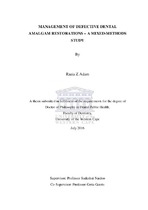| dc.contributor.advisor | Naidoo, Sudeshni | |
| dc.contributor.author | Adam, Razia Zulfikar | |
| dc.date.accessioned | 2018-02-27T10:50:45Z | |
| dc.date.available | 2018-02-27T10:50:45Z | |
| dc.date.issued | 2016 | |
| dc.identifier.uri | http://hdl.handle.net/11394/5730 | |
| dc.description | Philosophiae Doctor - PhD (Community Oral Health) | |
| dc.description.abstract | Much variation exists in the practice of dentistry with regard to the
diagnosis of caries and the recommendations for treatment. Even though criteria
for the selection of 'faulty' restorations often appear ill-defined, subjective and/or
variable restoration replacement is a major component of dental practice in
developed countries (Brennan and Spencer, 2006). While the prevalence of caries
is decreasing in developed countries, low- and middle-income countries are
experiencing an increase. The investigation of factors influencing the clinical
decision-making process has identified and compared the roles of technical (e.g.
oral health factors), patient and dentist factors (Brennan and Spencer, 2006; Bader
and Shugars, 1995a; 1995b). A recent trend for a more conservative approach to
restorative dentistry has led to the alternative management of defective dental
restorations. Repair and refurbishment of defective dental restorations have been
established as viable options. The purpose of this study was to provide
information regarding the practices, knowledge and attitudes of South African
dentists with regard to the management of defective dental amalgam restorations. | |
| dc.language.iso | en | |
| dc.publisher | University of the Western Cape | |
| dc.title | Management of defective dental Amalgam restorations-a mixed-methods study | |
| dc.rights.holder | University of the Western Cape | |

